#Apollo Applications Program
Explore tagged Tumblr posts
Text

Portraits of all three Skylab Astronaut crews.
source
#Skylab II#Skylab 2#SL-2#SLM-1#Skylab III#Skylab 3#SL-3#SLM-2#Skylab IV#Skylab 4#SL-4#SLM-3#NASA#Apollo Program#Apollo Applications Program#Skylab Orbital Workshop#Skylab OWS#Skylab#Skylab I#Skylab 1#SL-1#undated#1970s#my post
49 notes
·
View notes
Text
Martin Titan III-L
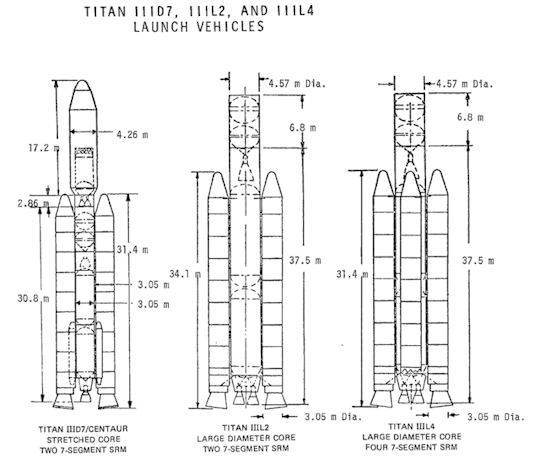
"The Titan III-L series was a Martin Marietta concept (late 1960’s into early 1970’s) for a heavy lift derivative of the Titan IIIC launch vehicle. The core would be increased in diameter from 10 feet to 15, and the number of liquid propellant rocket engines increased from two to four. Additionally, the vehicle could be given two, four or six solid rocket motors (Titan III-L2, Titan III-L4, Titan III-L6). The Titan III-L6 concept was considered as a first stage booster for the Space Shuttle.

The Titan III-L2 had enough lift capacity to launch an Apollo-derived capsule and service module, providing an alternative to the Saturn IB for space station logistics and crew transfer."
source
#Titan III-L#Titan III#Rocket#NASA#Apollo Program#Apollo Applications Program#1970s#concept art#my post
15 notes
·
View notes
Text
WHY DIGITIZE CULTURAL HERITAGE, AND FOR WHOM?
Many museums around the world make high-quality 3D scans of important artwork and ancient artifacts in their collections. Several forward-thinking organizations freely share their 3D scans, allowing the public to view, copy, adapt, and experiment with the underlying works in ways that have never before been possible.
Anyone in the world with an internet connection can view, interact with, and download the British Museum’s 3D scan of the Rosetta Stone, for example. The public can freely access hundreds of scans of classical sculpture from the National Gallery of Denmark, and visitors to the Smithsonian’s website can view, navigate, and freely download thousands of high-quality scans of artifacts ranging from dinosaur fossils to the Apollo 11 space capsule.
With access to digitizations like these, artists can rework and incorporate our common cultural heritage into new works, such as films, video games, virtual reality, clothing, architecture, sculpture, and more. Researchers and educators can use 3D scans to further our understanding of the arts, and the art-loving public can use them to appreciate, study, and even replicate beloved works in new ways that are not possible within the confines of a museum or with the original works. [...]
Unfortunately, some ostensibly public-spirited organizations do keep their 3D scans hidden. I’ve been trying to help them see the light. Beginning in 2017 I spent three years using German freedom of information law to successfully pressure the Egyptian Museum of Berlin to release its 3D scan of its most prized possession and national treasure, the 3,000 year-old Bust of Nefertiti. Since then I’ve turned my attention to the digital treasures being hoarded by taxpayer funded institutions in France.
The Louvre, for example, will not allow the public to access its ultra-high quality 3D scan of Winged Victory, the Nike of Samothrace, despite its aggressive public and corporate fundraising campaign to digitize the iconic Greek sculpture. Nor its scan of Venus de Milo.
The French Ministry of Culture’s Réunion des musées nationaux (RMN) receives tens of millions of dollars anually in public subsidies to provide services to French national museums. [...] RMN advertises its scans’ availability to the public, which makes for great PR, but its ads are false. In fact, RMN has a strict look-but-don’t-touch policy for its 3D scans and absolutely refuses to allow the public to access them directly. My own investigation has revealed that, in private, RMN admits it won’t release its scans because it wants to protect its gift shops’ sales revenue from competition from the public making their own replicas. For practical applications and creative potential, and direct value to the public, it is as though these scans simply do not exist.
And then there is the Rodin Museum. Founded in 1917 shortly after the death of famed sculptor Auguste Rodin, le musée Rodin is a state-run administrative agency and an arm of the Ministry of Culture. It has a legally mandated mission to preserve, study, enhance and disseminate Rodin’s works, all of which have been in the public domain since their copyrights expired decades ago. Even though musée Rodin never passes up an opportunity to remind the public that it is France’s sole “self-funded” national museum, it sought and obtained direct public funding from the Ministry of Culture’s national digitization program, and in 2010 as part of its public service mission began 3D scanning its collection with the stated purpose of publishing the results.
Fourteen years later, musée Rodin’s scans have not been shared with the public. [keep reading]
- Cosmo Venman

The Baltimore Museum of Art’s unpublished 3D scan of The Thinker.
15 notes
·
View notes
Note
Wait. Math logic is second year of college? Wait. Wait. Wait. I’m actually dumbfounded. Ridiculed. Gobsmacked.
Long story short, in my quaint little southern town the schools had this “intense, mathematically focused” summer program going on with the colleges nearby. 30 students would be chosen from all the middle schools (there were 5 or 6 so 5 or 6 kids were chosen from every middle school) based on resumes and essays on why they should be chosen. They had us compete for it. And me, being thrust into a classroom of about four others at the time routinely every week as a gifted child holding promise, was basically told “You are expected to sign up for this.” So I did. And I got a spot. So summer rolls around, and this thing is for like four years, alright? Four summers. Each summer is different. But that first summer for first years, you guessed it, included math logic. I was in 6th grade at the time. Learning math logic. They didn’t even introduce it as a lesson. In the middle of summer they gave us a test, and we had tests basically every other day to record our progress, but the second half of this particular test had graphs of carrots and p’s and q’s and squiggly lines. After, our professor went “Haha, you weren’t expecting that, were you?” NO. No, sir, I wasn’t. Then I checked the packet they handed us at the beginning of the summer, and there it was: Year 1. Logic and its Applications to Mathematics. Oh, goody. (Conveniently right before Introduction to Engineering.) Then for the rest of my high school years I never saw it come up in its full form. It was maybe teased once or twice. If that isn’t enough to figure out what the rest of the three summers was like, good. (Year 2 was Physics-based. Year 3 computer science and computer engineering based. Year 4 was straight up a well-oiled machine of the 9 nine rings of hell. Fun. Somehow.)
I love casually nerd Apollo, anyway. Makes me feel it all wasn’t for nothing when I nonchalantly bring something up in conversation and see them remember before my eyes that I was a child genius of some sort. <3
(For reference, this is referring to this post lmao)
I'm starting to think my school was either behind on math education or everyone else is put ahead lmao
NERD APOLLOOOOOOO
#the oracle speaks#asked and answered#anonymous#the trials of apollo#trials of apollo#pjo apollo#toa apollo
8 notes
·
View notes
Text
Just ordered this after having added it to wish list last year. Insomnia, pain, it was the perfect time to order a book with money I really needed to save for the upcoming heating bill. ;D But, hey, book was about 20% off, got free shipping, and there was a seven dollar gift card balance I didn't know I had that amazon applied to it. I'm going to call it a wise order. ;D

Nuclear Rockets: To the Moon and Mars Paperback – April 16, 2023 by Manfred "Dutch" von Ehrenfried (Author) 4.0 out of 5 stars (2) See all formats and editions So why is NASA refocusing its efforts on Nuclear Thermal Propulsion now, when chemical propulsion is so well established for human spaceflight? The reason is that future proposed flights are getting much longer and studies have shown that long-duration, weightless spaceflight has a lot of deleterious effects on the human body. When considering a flight to Mars takes a minimum of 2-3 years roundtrip, anything we can do to shorten the total mission time is highly desirable; if not mandatory. The longer the mission, the more exposure to galactic cosmic radiation, solar particles and coronal mass ejections, medical problems, and potential emergencies. A first-generation nuclear cryogenic propulsion system could propel human explorers to Mars more efficiently than conventional spacecraft, reducing the crews' exposure to harmful space radiation and other effects of long-term space missions. It could also transport heavy cargo and science payloads. A nuclear rocket engine uses a nuclear reactor to heat hydrogen to very high temperatures, which expands through a nozzle to generate thrust. Nuclear rocket engines generate higher thrust and are more than twice as efficient as conventional chemical rocket engines; just what’s needed for the crew to better survive the long-duration missions to Mars. In 1959, NASA replaced the Air Force in the development of the nuclear rocket and the mission changed from a nuclear missile to a nuclear rocket for long-duration space flight. Working with the DOE National Laboratories they worked on various research projects for 17 years including the Rover, NERVA, Kiwi, Pewee, and Phoebus rockets. In the late 1960s, the rising cost of the Vietnam War put increased pressure on budgets. It was determined that the Apollo program did not need nuclear rockets. Over the years, Congress support for the nuclear thermal propulsion projects including the Saturn upper stage, lunar and Mars missions, and the "Grand Tour" of the Solar System waned; nuclear rocket efforts were canceled in 1973. Now, there is renewed interest in picking up from those early efforts to produce nuclear rockets using state-of-the-art technology for deep space missions. NASA, DOD, and DARPA have teamed up to let contracts to many aerospace companies in order to define the best designs for nuclear thermal propulsion and nuclear fission power for surface energy applications. This book covers the past and present efforts that will lead to supporting near future cis-lunar and Mars missions. " Publisher : Independently published (April 16, 2023) Language : English Paperback : 270 pages ISBN-13 : 979-8377421252 Item Weight : 1.22 pounds Dimensions : 6.69 x 0.64 x 9.61 inches
3 notes
·
View notes
Note
i always see your apollo posting and i was just reminded by my dad today when black history month came up that one of my great aunts was one of the seamstresses that made the spacesuits for the apollo missions which is super cool and you’re like the only person i know who would find that interesting lol
she was a seamstress and made girdles and bras at playtex and was hired by ILC because her skills were applicable!
Oh wow that is awesome!!! Seamstresses have been such a critical part of the space program since its inception for things like parachutes and spacesuits because they require a level of precision sewing that only seamstresses were able to achieve. The thing with a spacesuit is that it is basically a self-contained little spaceship, with its own life support system and everything, so you have to be able to bind it in such a way that it maintains air pressure inside while still allowing for maneuverability for the astronaut. Without seamstresses like your great aunt, we wouldn't have been able to put people on the moon!
Post-Apollo, some of those seamstresses went on to work on the Shuttle in a couple different ways. There's the Shuttle pressure suits for launch and reentry, the Shuttle spacewalk suits (known as EMUs), and the Shuttle itself! A number of areas on the space shuttle orbiters had as part of their heat shield system these thermal blankets. On the exterior, they looked a little like quilts, and part of that is because they hired quilters to do precision sewing.
Theres still a lot of sewing that goes into modern space suits, too. The David Clark Company in Worcester MA, whose relationship with NASA goes back to the Gemini program, is currently making the launch and reentry pressure suits for the Artemis program based around their work on the Shuttle suits. And for moonwalking, Axiom Space is working with fashion company Prada to design the suits for future moon missions. The Prada partnership really hearkens back to those Apollo-era partnerships to me I really enjoy that.
You are correct in your assumption that I find that interesting lmao but yeah no that is literally so cool. And whether or not other people find it interesting, it's still a remarkable thing that your great aunt did, and many of the astronauts made a point of acknowledging the hardworking people on Earth who created the technology that allowed us to bring humanity to the moon.
5 notes
·
View notes
Text


SwRI is sending its first instrument to the lunar surface to survey the Moon’s interior
LMS instrument aboard the Blue Ghost Lander heading to Mare Crisium in early 2025
Through NASA’s Commercial Lunar Payload Services (CLPS) initiative, Southwest Research Institute developed the Lunar Magnetotelluric Sounder (LMS) to characterize the structure and composition of the Moon’s mantle by measuring electric and magnetic fields. The LMS instrument — manifested on the Blue Ghost lunar lander developed by Firefly Aerospace and targeted to launch on January 15, 2025 — will be the first SwRI instrument to touch the lunar surface. “For more than 50 years, scientists have used magnetotellurics on Earth for a wide variety of purposes, including to find oil, water, geothermal and mineral resources as well as to understand geologic processes such as the growth of continents,” said SwRI’s Dr. Robert Grimm, principal investigator of LMS. “The LMS instrument will be the first extraterrestrial application of magnetotellurics. NASA’s Artemis program is developing a series of increasingly complex missions to ultimately build a sustained human presence at the Moon for decades to come. To support these goals, LMS is part of a 14-day lunar lander mission to help understand the Moon’s subsurface in a previously unexplored location. Mare Crisium is an ancient, 350-mile-diameter impact basin that subsequently filled with lava, creating a dark spot visible to the naked eye on the Moon. Early astronomers who dubbed dark spots on the moon “maria,” Latin for seas, mistook them for actual seas. Mare Crisium stands apart from the large, connected areas of dark lava to the west where most of the Apollo missions landed. These vast, linked lava plains are now thought to be compositionally and structurally anomalous with respect to the rest of the Moon. From this separate vantage point, LMS may provide the first geophysical measurements representative of most of the Moon. Magnetotellurics uses natural variations in surface electric and magnetic fields to calculate how easily electricity flows in subsurface materials, which can reveal their composition and structure. LMS will allow scientists to probe the interior of the Moon to depths up to 700 miles or two-thirds of the lunar radius. The measurements will shed light on the material differentiation and thermal history of our Moon, a cornerstone to understanding the evolution of solid worlds. The LMS instrument ejects cables with electrodes at 90-degree angles to each other and distances up to 60 feet. The instrument measures voltages across opposite pairs of electrodes, much like the probes of a conventional voltmeter. The magnetometer is deployed via an extendable mast to reduce interference from the lander. The method reveals a vertical profile of the electrical conductivity, providing insight into the temperature and composition of the penetrated materials in the lunar interior. “The five individual subsystems of LMS, together with connecting cables, weigh about 14 pounds and consume about 11 watts of power,” Grimm said. “While stowed, each electrode is surrounded by a ‘yarn ball’ of cable, so the assembly is roughly spherical and the size of a softball.” The LMS payload was funded for delivery to the lunar surface through NASA’s CLPS initiative. SwRI designed the instrument, built the electronics box and leads the science investigation. Goddard Space Flight Center provided the LMS magnetometer to measure the magnetic fields, and Heliospace Corp. provided the magnetometer mast and four electrodes used to measure the electrical fields. Under the CLPS model, NASA is investing in commercial delivery services to the Moon to enable industry growth and support long-term lunar exploration. As a primary customer for CLPS deliveries, NASA aims to be one of many customers on future flights. NASA’s Marshall Space Flight Center in Huntsville, Alabama, manages the development of seven of the 10 CLPS payloads carried on Firefly’s Blue Ghost lunar lander.
TOP IMAGE: From within the Mare Crisium impact basin, the SwRI-led Lunar Magnetotelluric Sounder (LMS) may provide the first geophysical measurements representative of the bulk of the Moon. Most of the Apollo missions landed in the region of linked maria to the west (left image), whose crust was later shown to be compositionally distinct (right image) as exemplified by the concentration of the element thorium. Mare Crisium provides a smooth landing site on the near side of the Moon outside of this anomalous region. Credit NASA
LOWER IMAGE: LMSwRI led the development of the LMS instrument for the Mare Crisium lander mission, which includes (from left) a magnetometer, a central electronics box and four spring-launched electrodes. Credit Southwest Research Institute
6 notes
·
View notes
Text
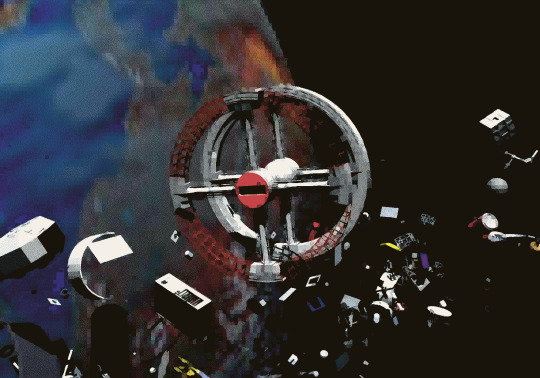
The interior of the rocket is instantly disconcerting. The entire thing is turned sideways. You can see several rows of seats extending downwards. The backs of the seats are against a wall, which houses a hefty-looking DOOR. There are rungs built into the wall that would allow you to climb down safely. Above you is an array of CRT MONITORS covering most of the wall.
Look around>
The lights are warm and dim, something much more comforting than the concerning red that bathes most of the Apollo facilities. The interior is made of glossy, smooth plastic and even has carpeted floors. You're surprised by the level of comfort it prioritizes. There also appears to be a communications TERMINAL next to the ladder.
Go to door>
You climb down the ladder and walk on the "wall", then lean down and examine the door. It has a large WHEEL on it.
Turn wheel>
You crank the wheel and pull. The door swings open. Looks like it was designed to keep the air inside in case of a breach. That's a smart safety feature. You look down at the room below. It's all empty racks and shelves, abandoned straps and hooks, and slots on the floor. It looks like it was designed to keep luggage and supplies secure. You close the door behind you and turn the handle back. There doesn't seem like any reason to keep it open.
Look at monitors>
You climb back up and look at the monitors. You recall that you never saw any windows on the rocket when you looked at it from the outside. Maybe the monitors are what let you see the outside?
Look at terminal>
The only familiar thing on the terminal is the INSTANT MESSENGER. There's also a program called STARTUP. You could probably use Heresy's advice now.
Talk to Heresy>
[HERESY is ONLINE]
Luna1: Hi Heresy.
Heresy: I see you made it to the rocket.
Luna1: Yeah, I did.
Luna1: But I don't know how to launch it.
Luna1: There's no obvious launch button.
Heresy: Those rockets were surprisingly autonomous and automated.
Heresy: They used a computer to run it.
Heresy: I should be able to help you launch.
Luna1: This seems kinda dangerous…
Heresy: You'll be ok, Sofia.
Heresy: Nothing can happen to you.
Heresy: I promise.
Luna1: Ok….
Luna1: So what do I do?
Heresy: Make sure the doors are closed and buckle yourself in.
Heresy: The terminal should have a few options for starting up the monitors and putting it in launch mode.
Heresy: Once you set those things up I can start it from my side.
You minimize the messenger. It sounds like Heresy was talking about the STARTUP program.
Use startup>
You double-click the application and it opens. The screen lights up with a flashy UI which features a short list of BUTTONS. They read monitors, safety check, and launch mode.
Use buttons>
You click every button in turn. The monitors start to whine and turn on soon after, displaying a clear view of the sky from the rocket's position on the launchpad. The cameras must be on the nose of the ship. When you click the safety check, a diagnostic program starts running and a loading bar appears. You barely even see it before it disappears, though. Seems like it's perfectly functional despite everything. Finally, you click launch mode. The program changes to a message.
"PLEASE TAKE YOUR SEAT AND BUCKLE UP FOR YOUR SAFETY. CLOSE MAIN HATCH BEFORE LAUNCH."
Ah, right, the HATCH. It would be a bad idea to leave it open during launch.
Close hatch>
You swing the hatch shut and turn the wheel on your side. Everything should be set up now. You need to let Heresy know.
Talk to Heresy>
Luna1: I think everything is set up now.
Heresy: Good.
Heresy: I saw that you set it to launch mode.
Luna1: Yeah.
Luna1: So I guess this is it then?
Heresy: Yeah. Buckle yourself in and I'll trigger the launch remotely.
Heresy: The course is already projected.
Something is bothering you. You pause a bit before sending your next message.
Luna1: Do I really have to go?
Heresy: What do you mean?
Luna1: I'm not sure if I'm ready to leave yet.
Luna1: I'm going to miss everyone a lot.
Heresy: You don't have to leave right now.
Heresy: You can stay as long as you like.
Heresy: But the thing is, your fate was already decided.
Heresy: At some point you'll decide to come anyway.
You think about her words for a while.
Luna1: How do you know?
Heresy: Because God told me, Sofia.
Heresy: I reached out to Luna for a reason.
Heresy: And I knew when you found me that you were who I was sent to find.
Heresy: We're both part of something bigger than us.
Heresy: That's why I need you.
You leave her waiting for a while again, trying to sort out your own conflicting emotions. But eventually you decide.
Luna1: Ok, I'm going to buckle up now.
You get into the seat nearest to the terminal and strap yourself in. The chair has excessive padding and buckles, and the headrest feels like more than just comfort. You look up at the grid of monitors. Something new has started to form on them. There's an overlap charting out the course to Earth from Luna. And then a countdown. As the countdown the rocket starts to rumble, more and more, and you can see the camera views start to show smoke drifting up. As soon as it begins the camera view cuts out, showing only the grid and leaving you in the dark to wait in anticipation. And then, liftoff.
You're pressed back into the seat as the rocket launches. Everything it shaking violently. You can faintly hear ripping and tearing metal and the booms of scattered vehicles and equipment flying from the thrust of the launch. The entire facility is probably demolished. But you can't afford to focus on that now. More and more pressure is piled onto you, and then you black out.
…
….
…..
You wake up suddenly, gasping desperately for air and trembling. You look around. Things are floating in the cabin. The cameras are back on, and you can see Earth in view, surrounded by the inky void and twinkling stars. As you slowly approach the planet, you notice what looks like a dense glittering silver ring around it. You're left to this view for quite a while. A timer in the corner of the grid says it'll be a number of hours before you make it. Eventually, you pass out.
…
….
…..
You awake at the jolt of the rocket. You're right inside the dense ring now. Now that you're closer, you can see what it's made of; metal scraps and debris. The rocket rumbles and shakes again. You must be bumping into the space debris. How many satellites and facilities were launched into orbit to create a ring this dense? You wonder for a moment, and the rocket shakes again. The lights flicker this time. You're getting nervous. Suddenly, you feel the thrusters again, and the pressure builds. It looks like you're coming in for an entry. The rocket slowly descends into the atmosphere, and as flames appear to build against the nose of the rocket the cameras cut out again. The ship rumbles and shakes more and more, and the pressure against you builds. A warning message appears and the lights flash red.
"WARNING: CRASH LANDING"
You close your eyes and feel the impact of the rocket slamming into the ground.
And then nothing.
NEXT
PREVIOUS
7 notes
·
View notes
Note
wait what’s happening on reddit?
From what I’ve read here, Reddit‘s pulling a Twitter and planning to charge ( a LOT of) money for third-party applications to use their API - meaning a lot of things will be forced to go offline forever.
Those include ALL third-party apps, which is important because Reddit‘s own app seems to be an utter mess that makes tumblr‘s look like the best programmed thing in the world, so pretty much everyone uses Reddit over those instead. Like, someone did the math for one of the main 3rd-apps, Apollo, and it would’ve cost the single guy who’s programming it 20mil$. Per month. And unless they changed it since last time I tried to go on there, you can’t use web-Reddit on your phone because they won’t let you click a single thing or even look at most subreddits without blocking it behind a "use the app“! Popup. Ik Tumblr does that too, but at least it actually. Let’s you look at tumblr. Kinda ironic that their app is such trash then.
More importantly however, the Reddit App isn’t compatible with native text-to-speech help for blind/visibly impaired people, while all those 3rd party apps are/were- so they’re essentially fucking over all blind/visibly impaired people and making it impossible for them to use Reddit at all.
And also a lot of very important tools for MODERATION. Which mods are apparently really dependent on especially on bigger subreddits because otherwise the workload would be insane + a lot of moderation stuff a lot harder. So. Yknow. They’re basically forcing mods, who do this *for free* to pay money to keep their own site afloat. Or letting subs go haywire and then nuked for not following general Reddit guidelines.
Because of that A LOT of subreddits decided to go on strike for 48h and set to private, resulting in like7700/8somethingthousand of them to go black, which then resulted in the whole site crashing from the amount of change.
Why people migrated to tumblr of al places seems to be kind of a mystery, but my own guess is either because tumblr became the official refugee-site after the whole thing with Twitter before, or because r/196, one of the really big subreddits, closed indefinitely instead of just those 48h (just as a sidenote, is how strikes should work, because otherwise they’ll just wait out the hours instead of doing anything- which is apparently also exactly what happened now).
Anyways that subreddit is apparently Reddit’s version of tumblr anyways so the vibe seemed to fit. And now the 196 tag is trending and probably here to stay for a while lmao
#another anon ask#though I wonder what happens if 196 really does stay#does it get its own category in the tags then?#because the way trending tags seem to work it’d just stay in first place for all time#which would be very funny tho
3 notes
·
View notes
Text
IPTV Smarter Player Lite – The Ultimate IPTV Streaming Solution
Streaming live TV, movies, and sports has never been easier with IPTV Smarter Player Lite. This lightweight IPTV player is designed to provide a seamless and user-friendly experience for IPTV users worldwide.
With the growing demand for internet-based television, IPTV Smarter Player Lite offers a reliable platform to access premium content without the limitations of traditional cable TV. In this guide, we will explore the key features, installation process, and best IPTV services that work with IPTV Smarter Player Lite.
What is IPTV Smarter Player Lite?
IPTV Smarter Player Lite is an advanced IPTV player that enables users to stream live TV, VOD (Video on Demand), and TV series from their IPTV providers. Unlike other players, it is designed for efficiency, ease of use, and compatibility with multiple devices.
Top Features of IPTV Smarter Player Lite
✔ Smooth and Intuitive Interface – Easy navigation and quick access to content ✔ HD & 4K Support – High-quality streaming for an immersive experience ✔ Multi-Screen Viewing – Watch multiple channels at once ✔ Advanced EPG Support – Access to electronic program guides for better scheduling ✔ Customizable User Experience – Adjust subtitles, audio, and layout ✔ Cross-Platform Compatibility – Works on Android, iOS, Windows, macOS, and Firestick
How to Install IPTV Smarter Player Lite?
Step 1: Download the App
To start using IPTV Smarter Player Lite, download the application from a trusted source.
It is available for the following devices:
Android (Phones, Tablets, Android TV)
iOS (iPhone, iPad, Apple TV)
Windows & macOS
Firestick & Smart TVs
Step 2: Install and Set Up the App
For Android: Install the APK file after enabling "Unknown Sources" in security settings.
For Windows/macOS: Download and install the app like any standard software.
For Firestick: Use the Downloader app to install IPTV Smarter Player Lite.
Step 3: Add Your IPTV Subscription
Once installed, launch the app and enter your IPTV provider’s details:
M3U Playlist URL
Xtream Codes API Login
EPG Link for Program Guide
After entering your credentials, refresh the app, and you will have access to all your IPTV channels and VOD content.
Best IPTV Services Compatible with IPTV Smarter Player Lite
1. Xtreme HD IPTV
Offers 20,000+ live channels, HD streaming, and premium sports coverage.
2. Apollo Group TV
A reliable IPTV service known for high-quality content and a rich VOD library.
3. BestBuy IPTV
Provides a diverse range of channels with minimal buffering issues.
4. IPTV Trends
Popular for stable connections, 4K support, and international channels.
5. King IPTV
A premium IPTV provider with thousands of live TV options.
6. Sportz TV IPTV
Perfect for sports enthusiasts, offering live games and pay-per-view events.
7. Yeah IPTV
A budget-friendly option with great channel selection.
8. The Amazing TV
A highly rated IPTV service supporting IPTV Smarter Player Lite.
9. Beast TV IPTV
Known for high-quality HD and UHD streaming.
10. Necro IPTV
Provides a well-rounded IPTV experience with reliable servers and excellent content variety.
Why Choose IPTV Smarter Player Lite?
If you’re looking for a high-quality IPTV player, IPTV Smarter Player Lite is an excellent choice. Unlike other players, it supports multiple streaming formats, offers high-definition content, and has an intuitive interface that makes navigation effortless.
With the ability to stream content across multiple devices and access customizable settings, IPTV Smarter Player Lite stands out as a preferred IPTV solution for users who want uninterrupted entertainment.
Frequently Asked Questions (FAQs)
1. Is IPTV Smarter Player Lite free?
Yes, the app is free, but you need an IPTV subscription for streaming content.
2. Can I use IPTV Smarter Player Lite on Firestick?
Yes, you can install it on Firestick using the Downloader app.
3. Does IPTV Smarter Player Lite support subtitles?
Yes, the app allows you to enable and customize subtitles for a better viewing experience.
4. Is IPTV Smarter Player Lite legal?
The app itself is legal, but ensure that your IPTV service provider complies with legal streaming regulations.
5. How can I fix buffering issues in IPTV Smarter Player Lite?
Make sure you have a strong internet connection (at least 10 Mbps for HD and 25 Mbps for 4K streaming) and use a reliable IPTV provider.
Conclusion
If you’re looking for a fast, efficient, and feature-rich IPTV player, IPTV Smarter Player Lite is a top-tier choice. It offers high-definition streaming, multiple device compatibility, and a user-friendly interface, making it perfect for IPTV users.
By choosing a reliable IPTV service and following the installation steps, you can enjoy unlimited entertainment with live TV, movies, sports, and more.
Sources
Wikipedia - IPTV
TechRadar
CNET
Forbes Tech
Tom’s Guide
0 notes
Text
Research: The Space Race

The Space Race was a Cold War competition between the United States and the Soviet Union to achieve superiority in spaceflight, starting with the Soviet Union's launch of Sputnik in 1957 and culminating in the US landing on the moon.
Causes of the Space Race

Sputnik 1
After the ending of the World War II, a new conflict began in between the US and the soviets known as the Cold war. During the Cold war both countries started to compete to have the best in everything from technological and ideological aspects. With the launch of Sputnik 1, the first artificial satellite, in 1957, shocked the United States and marked the beginning of the Space Race. Space was a crucial and new arena for the Cold War rivalry. Before a watchful world, each side sought to demonstrate its superiority through impressive feats in rocketry and spaceflight. In addition to these milestones, technologies used for spaceflight had further applications. Rockets could launch missiles, while satellites could keep an eye on adversaries.
NASA Is Created

Explorer I
In 1958, the United States launched its own satellite, Explorer I, designed by the U.S. Army under the direction of rocket scientist Wernher von Braun. That same year, President Dwight D. Eisenhower signed a public order creating the National Aeronautics and Space Administration (NASA), a federal agency dedicated to space exploration.
Eisenhower also created two national security-oriented space programs that would operate simultaneously with NASA’s program. The first, spearheaded by the U.S. Air Force, dedicated itself to exploiting the military potential of space. The second, led by the Central Intelligence Agency (CIA), the Air Force and a new organization called the National Reconnaissance Office (the existence of which was kept classified until the early 1990s) was code-named Corona; it would use orbiting satellites to gather intelligence on the Soviet Union and its allies.
Space Race Heats Up

Lunar 2

Vostok 1
In 1959, the Soviet space program took another step forward with the launch of Luna 2, the first space probe to hit the moon. In April 1961, the Soviet cosmonaut Yuri Gagarin became the first person to orbit Earth, traveling in the capsule-like spacecraft Vostok 1. For the U.S. effort to send a man into space, dubbed Project Mercury, NASA engineers designed a smaller, cone-shaped capsule far lighter than Vostok; they tested the craft with chimpanzees and held a final test flight in March 1961 before the Soviets were able to pull ahead with Gagarin’s launch. On May 5, astronaut Alan Shepard became the first American in space (though not in orbit).
Later that May, President John F. Kennedy made the bold, public claim that the U.S. would land a man on the moon before the end of the decade. In February 1962, John Glenn became the first American to orbit Earth, and by the end of that year, the foundations of NASA’s lunar landing program dubbed Project Apollo were in place.
0 notes
Text
Cancelled Missions/Station: Manned Orbital Research Laboratory (MORL)

This was a study initiated in 1962 for space stations designs using the Gemini Spacecraft and later on the Apollo CSM. Boeing and Douglas received Phase I contracts in June 1964.


MORL/S-IVB Concept
"A 5 metric ton 'dry' space station, launched by Saturn IB, with Gemini or Apollo being used for crew rotation. The 6.5 meter diameter and 12.6 meter long station included a docking adapter, hangar section, airlock, and a dual-place centrifuge. Douglas was selected by NASA LaRC for further Phase 2 and 3 studies in 1963 to 1966. Although MORL was NASA's 'baseline station' during this period, it was dropped by the late 1960's in preference to the more capable station that would become Skylab.



Different docking concepts studied.
The Manned Orbital Research Laboratory was the brainchild of Carl M Houson and Allen C. Gilbert, two engineers at Douglas. In 1963 they proposed a Mini Space Station using existing hardware, to be launched by 1965. A Titan II or Atlas would be launched with a payload of control system, docking adapter and hangar module. The visiting crew would use the payload to transform the empty fuel tank of the last stage of the rocket into pressurized habitat (a so-called 'wet' space station). Provisions were available for 4 astronauts for a 100 day stay. Crew members would arrive two at a time aboard Gemini spacecraft. Equipment included a two-place centrifuge for the astronauts to readapt to gravity before their return to earth.

An early MORL concert. Artwork by Gordon Phillips.


In June 1964 Boeing and Douglas received Phase I contracts for further refinement of MORL station designs. The recommended concept was now for a 13.5 metric ton 'dry' space station, launched by Saturn IB, with Gemini or Apollo being used for crew rotation. The 6.5 meter diameter and 12.6 meter long station included a docking adapter, Hangar section, airlock, and a dual-place centrifuge.

"Medium-sized orbiting lab is this Manned Orbital Research Laboratory (MORL) developed for NASA's Langley Lab by Douglas Missiles & Spacecraft Division. The lab which weighs about 35,000 pounds, could maintain 3 to 6 men in orbit for a year.
Orbiting Stations: Stopovers to Space Travel by Irwin Stambler, G.P. Putnam's Sons, 1965."
Douglas was selected by NASA LaRC for further Phase 2 and 3 studies in 1963 to 1966. The major system elements of the baseline that emerged included:
A 660-cm-diameter laboratory launched by the Saturn IB into a 370-km orbit inclined at 28.72 degrees to the equator
A Saturn IB launched Apollo logistics vehicle, consisting of a modified Apollo command module, a service pack for rendezvous and re-entry propulsion, and a multi-mission module for cargo, experiments, laboratory facility modification, or a spacecraft excursion propulsion system.
Supporting ground systems.
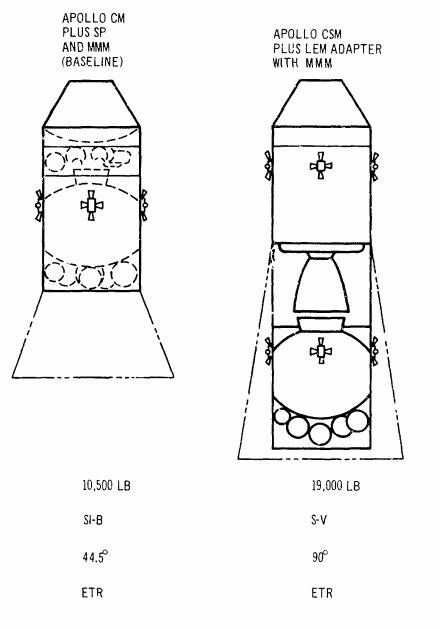

MORL Phase IIb examined the utilization of the MORL for space research in the 1970s. Subcontractors included:
Eclipse-Pioneer Division of Bendix, stabilization and control
Federal Systems Division of IBM, communications, data management, and ground support systems
Hamilton Standard Division of the United Aircraft Corporation, environmental control/life support
Stanford Research Institute, priority analysis of space- related objectives
Bissett-Berman, oceanography
Marine Advisors, oceanography
Aero Services, cartography and photogrammetry
Marquardt, orientation propulsion
TRW, main engine propulsion.
The original MORL program envisioned one or two Saturn IB and three Titan II launches. Crew would be 6 to 9 Astronauts. After each Gemini docked to the MORL at the nose of the adapter, the crew would shut down the Gemini systems, put the spacecraft into hibernation, and transfer by EVA to the MORL airlock. The Gemini would then be moved by a small manipulator to side of the station to clear docking adapter for arrival of the next crew."

"Docking was to have 3 ports, all Nose Dock config, with spacecraft modifications totaling +405 lbs over the baseline Gemini spacecraft (structure beef-up, dock provisions, added retro-rockets, batteries, a data link for rendezvous, temp. control equip. for long-term, unoccupied Gemini storage on-orbit and removal of R&D instruments)."
"Later concepts including docking a Saturn-IB launched space telescope to MORL. At 4 meter diameter and 15 meter long, this would be the same size as the later Hubble Space Telescope. The crew would have to make EVA's to recover the film from the camera.
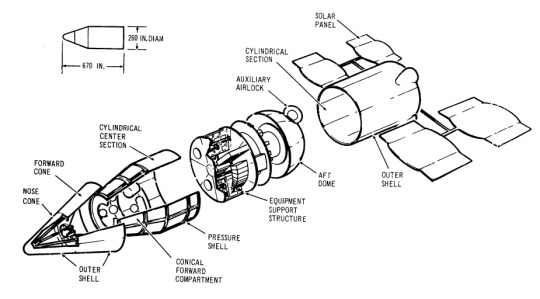
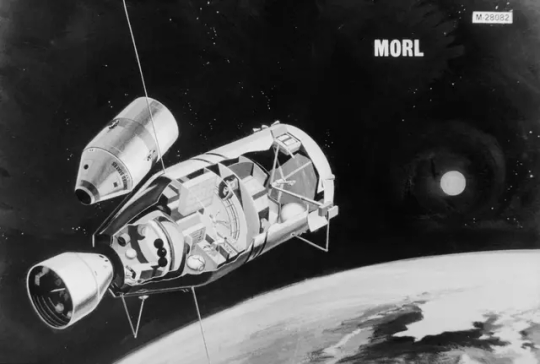
In 1965 Robert Sohn, head of the Technical Requirements Staff, TRW Space Technology Laboratories, proposed a detailed plan for early manned flight to Mars using MORL. The enlarged MORL-derived mission module would house six to eight men and be hurled on a Mars flyby by a single Saturn MLV-V-1 launch. MORL-derived Mars mission modules cropped up in other Douglas Mars studies until superseded by the 10-m diameter Planetary Mission Module in 1969.

MORL/Space Telescope
Why was MORL never launched ?
NASA had a need for a Space Station and MORL was little, easy and cheap. But NASA had more ambitious plans, embodied in the Apollo Applications Orbital Workshop (later called Skylab)."
-information from astronautix.com: link
source, source, source
NARA: 6375661, S66-17592
Posted on Flickr by Numbers Station: link
#Manned Orbital Research Laboratory#MORL#Space Station#Gemini#Gemini Program#Project Gemini#Apollo CSM Block II#Apollo Program#Saturn IB#Saturn I#S-IV#S-IVB#Apollo Applications Program#Cancelled#Study#1962#June#1965#my post
39 notes
·
View notes
Text
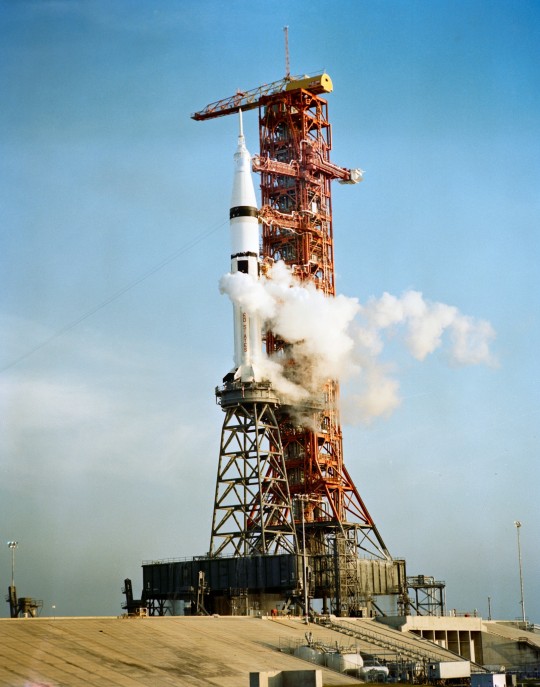
"A ground-level view of Pad B, Launch Complex 39, Kennedy Space Center, Florida, showing the Skylab 3/Saturn IB (CSM-117/SA-207) space vehicle during prelaunch preparations. The launch vehicle is venting liquid oxygen during pre-final countdown cryogenic loading."
Date: July 20, 1973
NASA ID: S73-31697
#Skylab III#Skylab 3#SL-3#SLM-2#CSM-117#SA-207#Saturn IB#Rocket#NASA#Apollo Program#Apollo Applications Program#LC-39B#Kennedy Space Center#Florida#July#1973#my post
15 notes
·
View notes
Text
Java training in Pammal
For those seeking Java training in Pammal, Apollo Computer Education offers in-depth courses designed to build a strong foundation in Java programming. Our Java training in Pammal includes theoretical lessons and practical coding sessions to ensure that you understand the core concepts and applications of Java. At Apollo Computer Education, our Java training in Pammal is led by experienced instructors who provide personalized attention to each student. Join our Java training in Pammal today and develop the technical skills needed to succeed in the world of Java development.

0 notes
Video
youtube
Skyhooks, Rotovators & Space Ladders: Lifting Humanity To The Stars Without Rockets
When I think of the things we're on the brink of being able to do (like building skyhooks and rotovators), and compare it with the idiotic things we're actually doing with our energies (like snatching vaccines away from African children and letting them rot in refrigerators), I'm reminded of Ray Bradbury's description of the cancellation of the Apollo Applications Program as being like reaching one hand over the top of the cliff and then performing the contortionist miracle of stomping on your own fingers so you fall back into the chasm.
0 notes
Text
Apollo Micro Systems: Strengthening Defence Systems Through Indigenisation
Apollo Micro Systems Limited (AMS), a key player in the defence, aerospace, and homeland security sectors, continues to reinforce its commitment to indigenisation and technological advancements. The company has released its investor presentation for the quarter ending December 31, 2024, showcasing its growth trajectory, manufacturing capabilities, and strategic direction.
Founded in 1985 and headquartered in Hyderabad, AMS has carved a niche for itself in designing, developing, and manufacturing mission-critical electronic and electromechanical systems. Over the years, the company has built a strong reputation as a trusted partner of the Defence Research and Development Organisation (DRDO), Bharat Electronics Limited (BEL), and other key stakeholders in the defence and space sectors. With a broad portfolio that includes weapons handling systems, secure communication solutions, electronic warfare systems, and air defence technologies, AMS is poised to drive innovation and self-reliance in India's defence ecosystem.
The company’s journey has been marked by significant milestones, from early contributions in electronic CAD design to the development of indigenous defence systems. AMS has played a crucial role in supporting India's missile programs, aerospace applications, and naval systems, gradually transitioning from being a buyer to a builder. In recent years, AMS has expanded its manufacturing infrastructure to cater to the growing demand for indigenous defence solutions. The establishment of its new Integrated Plant for Ingenious Defence Systems (IPiDS) in Hyderabad underscores its commitment to backward integration, enhancing in-house capabilities and production efficiency. This state-of-the-art facility, expected to be operational by the end of FY25, will position AMS as a premier Tier-1 OEM manufacturer.
As part of its strategic expansion, AMS has also acquired 2.5 acres of land to further bolster its manufacturing footprint. The company’s Unit-II facility, spanning 40,000 square feet, and its upcoming Unit-III facility at Hardware Park-II, Hyderabad, will add another 3,50,000 square feet of operational space. This significant growth in manufacturing capacity will enable AMS to scale up production and cater to the increasing demand for indigenous defence products.
Innovation and research remain at the core of AMS’s growth strategy. The company has been actively involved in more than 60 defence programs as a sub-system partner and has developed over 150 indigenous programs. With a robust Research & Development (R&D) team of 165+ professionals, AMS continues to drive technological excellence and strategic collaborations. Notably, AMS has entered the radio frequency (RF) and microwave domain through a strategic acquisition, reinforcing its capabilities in advanced defence electronics.
The investor presentation also highlights AMS’s corporate structure, which includes subsidiaries such as Ananya SIP RF Technologies Private Limited and Apollo Defence Industries Private Limited (ADIPL). In December 2024, AMS incorporated a new step-down subsidiary, Apollo Strategic Technologies Private Limited, with a 51% stake, further strengthening its presence in the defence manufacturing sector.
Certified under ISO 9001:2015 and CEMILAC, AMS adheres to stringent quality standards, ensuring reliability and precision in its offerings. The company’s dedication to excellence is reflected in its collaborations with leading defence institutions and its commitment to delivering cutting-edge solutions tailored to India’s defence and aerospace requirements.
As AMS charts its course for sustained growth, it remains steadfast in its mission to “Convert Your Concepts into Reality.” With a vision to emerge as a world-class solution provider offering “Total Solutions Under One Roof,” the company is well-positioned to play a pivotal role in India's journey towards defence self-reliance.
With its solid foundation, continuous innovation, and unwavering commitment to indigenisation, Apollo Micro Systems Limited is set to drive the future of defence technology, ensuring that India remains at the forefront of strategic and technological advancements.
0 notes